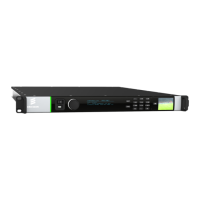
Do you have a question about the Ericsson AVP 1000 and is the answer not in the manual?
| Brand | Ericsson |
|---|---|
| Model | AVP 1000 |
| Category | Media Converter |
| Language | English |
Details the components and functionality of the unit's front panel.
Identifies the main units and options covered by this reference guide.
Details the capabilities offered by the AVP base chassis as standard.
Lists available option cards for purchase with the base chassis.
Details software value packs for augmenting AVP option card functionality.
Explains how licenses control feature availability and instances.
Important initial information for installation and safety.
Guidelines for fixing, rack mounting, and ensuring proper ventilation.
Details rear panel connectors for various signals and option cards.
Covers Data and Control Ethernet port specifications and connections.
Describes video and audio input/output interfaces for CE modules.
Details interfaces for Satellite Modulator, ASI, G.703, Sync, GPI, and Mini USB.
Details the physical connections for the AVP unit and its components.
Step-by-step guide for powering up the unit after installation.
Explains configuring the unit via Ethernet Data Output ports.
Procedures for setting the unit's IP address using the front panel menus.
Details the parameters and configuration for Ethernet control ports.
Covers configuration of the four gigabit Ethernet ports for data input and output.
Guide to configuring the AVP via the Graphical User Interface.
Provides recommendations for video configuration, including buffer modes and GOP structure.
Instructions for setting up 4K video encoding on the CE-HEVC option module.
Explains the bit rate tracking feature for optimizing output TS rate.
Details configuring Basic Interoperable Scrambling System (BISS) for services.
Describes splicing for inserting advertisements into MPEG-2 Transport Streams.
Explains the use of the optional Simplified View for day-to-day operation.
Overview of the front panel interface components and their functions.
Details the appearance and general features of the front panel display.
Describes the main menu structure and options accessible via the front panel.
Functions for saving, loading, exporting, and importing configurations.
Details device settings, alarms, and system configuration.
Accesses advanced menus for installed option cards.
Introduction to the AVP's web GUI, its architecture, and supported actions.
Provides detailed information about the device and transport streams.
Allows saving and restoring unit configurations.
Provides setup options for the device, including Quick Setup and Advanced Setup tabs.
Setup options for the outputs of the device, including streams, services, and components.
Provides information and access to functions for maintenance tasks.
Explains MPEG Transport Streams and their IP encapsulation.
Details the operation of redundant Ethernet data ports.
Functionality for switching operation states of services or the whole device.
Overview of VCM video processing and encoding capabilities.
Summarizes compression profiles, levels, bit rates, and modes.
Explains audio mode support across different buffer modes.
Covers VCM support for various input audio signals and encoding methods.
Lists all supported option cards for the current release.
Details recommended slotting for option cards and compatibility.
Describes various VCMs like CE-a, CE-a J2K, CE-x, CE-xA, CE-HEVC.
Details the ASI I/O card's general capabilities and interfaces.
Describes the G.703 Transceiver card's PDH output interface.
Explains the external sync input functionality and interface.
Details the functions supported by the GPI option card.
Describes the operation and control of the Satellite Modulator.
Procedure for upgrading unit software and firmware.
Information on handling option modules during insertion or removal.
Covers routine inspection, cleaning, and servicing procedures.
Information on Ericsson's services, warranty, and support packages.
Lists and describes alarms generated by control and data ports.
Provides a fault-finding philosophy and preliminary checks.
Lists initial troubleshooting steps to identify failure symptoms.
Fault-finding steps for issues related to power supply or unit not working.
Troubleshooting steps for inability to access the web GUI.
Procedures for checking if the unit can be pinged on the network.
Recording current configuration in a file for fault diagnosis.
Recording unit events for troubleshooting.
Methods for extracting and saving unit configurations.
Feature for capturing selective logs to an external log server.